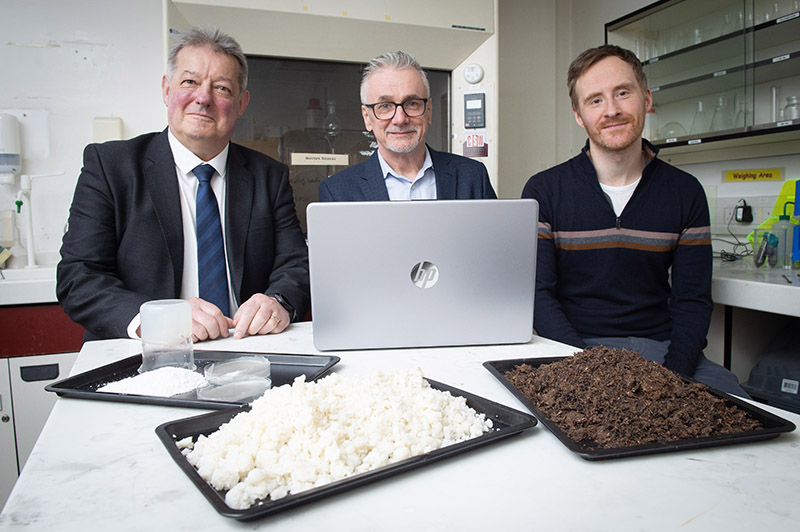
AN Edinburgh Napier University spinout’s approach to utilising seaweed as an alternative to plastics could help eliminate a range of microplastics found in packaging.
In the previous issue of Packaging Scotland, we reported the progress made by Mercel after its launch by Dominic O’Rourke and Dr Mark Dorris following a discovery with the learning institute’s advanced materials group found that high-value cellulose nanomaterial could be made from brown kelp extract.
Brown kelp is typically used in the sodium alginate industry, with the resulting waste products having traditionally been thrown back into the sea or repurposed as animal feed. Using a very low energy method, Mercel has been able to extract the cellulose from brown kelp using water, before repurposing it into a replacement for synthetic plastics in a range of practical uses including water barrier coatings for fresh food packaging, laundry pod binders, and hopefully in the future shock barrier coatings.
Concern is growing about the potential impact of microplastics on humans, with studies published in March by the University of New Mexico revealing microplastics to be found in every testicle and placenta tested by the learning institute. A 2022 Dutch study identified microplastics as present in the blood of 80% of test subjects, while research published in March this year by Naples’ University of Campania Luigi Vanvitelli found those with microplastics in their blood could be almost five times more likely to experience a stroke or heart attack.
Warning against being reactionary, Dr Dorris explained we likely won’t know the full extent of the impact on the human body for decades – and without proper legislation in place, there is a risk of jumping from one problem to another. In the meantime, Mercel hopes to increase its work to replace microplastics by opening a production plant in Fife by March 2025, which would enable the operation to process around one tonne of material a week.
“We think that’s probably the extent of what’s available in Scotland because you have to bear in mind this is a sustainable resource,” Dr Dorris added. “Our focus is on very low volume, very high value – and that’s the only way it’s going to work with a sustainable model.”
Currently working with 11 companies on 16 different initiatives, one standout case study is Mercel’s project to eradicate the synthetic polymer PVOH from a laundry detergent brand’s products.
Although currently considered not particularly harmful, New York City banned the sale of any laundry or dishwasher pods containing PVOH – which is used as a binder – in April, due to deeming it not readily biodegradable and persisting in the environment even once seemingly disappeared.
Dr Dorris explained the Mercel solution will bind enzymes and ingredients with laundry pods and sheets before releasing when in use.
“Our material is a nanomaterial, so whilst it’s not soluble in water it’ll go away in the waste stream and breakdown into carbon dioxide and water – it’s just cellulose which is the benchmark standard for biodegradability.”
Although the majority of interest in Mercel’s offering comes from America, the firm is working with fish producers in the north of Scotland to make their packaging recyclable. With polystyrene boxes now banned, Dr Dorris explained producers typically use single-use cardboard boxes with plastic liners.
“These boxes at the moment are not recyclable,” he continued. “We’ve got a water barrier coating that you can line cardboard boxes, so it can then just go into the recycling with the other cardboard – and that’s our focus, making cardboard better at the job, more water-resistant, and improving the structural integrity.”
Products such as coffee cups and ice cream tubs are other forms of packaging Mercel is hoping to target, with the company combining the cellulose with an edible wax that would give such packs water barrier properties and the ability to go into cardboard recycling streams. “We’re working with packaging companies on coatings and ingredients,” Dr Dorris said. “There’s nothing wrong with cardboard and other sustainable packaging, but we’re aiming to improve it and potentially make it more sustainable.”













